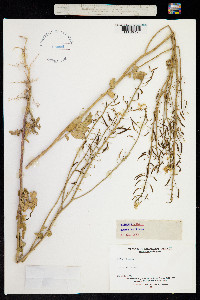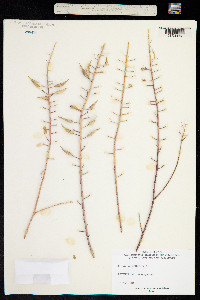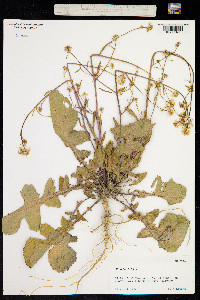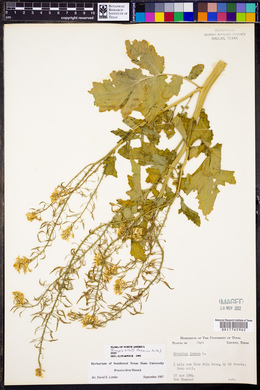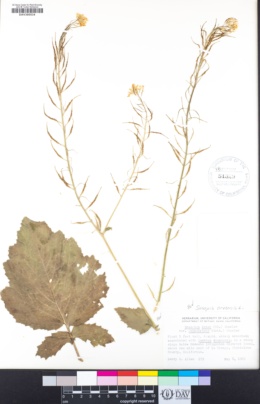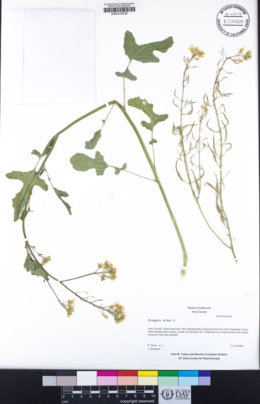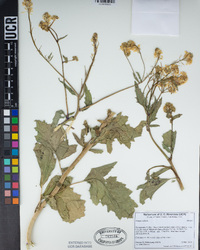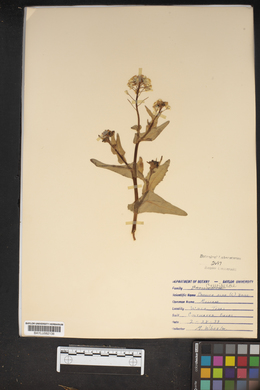Sinapis alba
|
|
|
|
Family: Brassicaceae
White-Mustard
[Brassica alba Rabenh., non L., moreBrassica hirta Moench, Sinapis foliosa Willd.] |
Plants usually hispid, rarely glabrous. Stems often branched distally, (0.15-)0.25-1(-2.2) dm. Basal leaves: petiole 1-3 (-6) cm; blade oblong, ovate, or lanceolate (in outline), (3.5-)5-14(-20) cm × 20-60(-80) mm, margins lyrate, pinnatifid, pinnatisect; lobes 1-3 each side, (oblong, ovate, or lanceolate, 1.5-2.5 cm), margins usually dentate or repand, rarely pinnatifid. Cauline leaves (distal) shortly petiolate; blade (ovate or oblong-ovate, 2-4.5 cm), margins coarsely dentate, rarely subentire. Fruiting pedicels divaricate, (3-)6-12(-17) mm. Flowers: sepals (3.8-)4-7(-8) × 1-1.8 mm; petals pale yellow, (7-)8-12(-14) × (3-)4-6(-7) mm; filaments (3-)4-7(-8) mm; anthers 1.2-1.5 mm. Fruits lanceolate, (1.5-)2-4.2(-5) cm × (2-)3-5.5(-6.5) mm; valvular segment terete or slightly flattened, (0.5-)0.7-1.7(-2) cm, 2-5-seeded per locule; terminal segment ensiform, flattened, (1-)1.5-2.5(-3) cm, equal to or longer than valves, seedless; valves hispid, trichomes of 2 types (subsetiform mixed with shorter, slender ones). Seeds pale yellow to pale brown, (1.7-)2-3(-3.5) mm diam. 2n = 24. Flowering Mar-Sep. Escape from cultivation, roadsides, waste places, disturbed areas, grain fields, cultivated areas, gardens, orchards; 0-1000 m; introduced; Greenland; Alta., B.C., Man., N.B., N.S., Ont., P.E.I., Que., Sask., Yukon; Ariz., Calif., Colo., Conn., Del., D.C., Ill., Ind., Iowa, Maine, Mass., Mich., Minn., Mo., Mont., Nebr., N.H., N.J., N.Mex., N.Y., N.C., N.Dak., Ohio, Okla., Oreg., Pa., R.I., S.C., S.Dak., Tenn., Tex., Utah, Vt., Wash., W.Va., Wis.; Eurasia; introduced also in Mexico, Central America, South America (Argentina), Europe, sw Asia, n Africa, Atlantic Islands. Of the three subspecies of Sinapis alba recognized in European and North African floras, only subsp. alba is naturalized in the New World. This taxon is an important crop plant, and is occasionally reported as a weedy escape from cultivation. Its seeds are used for the manufacture of condiment mustard (see also 17. Brassica), pickling spice, and production of oils for soap and mayonnaise, lubrication, and cooking (I. A. Al-Shehbaz 1985).
Annual herb 30 cm - 0.7 m tall Stem: roughly hairy. Flowers: 1.5 cm wide, in branched clusters (racemes). Mature flower stalks divergent, 6 - 15 mm long. Petals four, yellow. Fruit: a pod (silique), divergent or ascending, 10 - 15 mm long (without beak), 4 mm thick, bristly. Valves with three to five prominent veins. Beak 1 - 2 cm long (one to two times as long as the body), flat, and often curved. Seeds four to eight, 2 mm long. Lower leaves: alternate, pinnately divided (lyre-shaped), to 20 cm long, reverse egg-shaped, round-toothed, roughly hairy. Upper leaves: alternate, less pinnately divided or lobed than lower leaves, progressively reduced, reverse egg-shaped, toothed, roughly hairy. Similar species: No information at this time. Flowering: late May to late August Habitat and ecology: Introduced from Europe. An infrequent weed of waste ground and railroads. Occurence in the Chicago region: non-native Etymology: Sinapis comes from the Greek word sinapi, meaning mustard. Alba means white. Author: The Morton Arboretum Rough-hairy annual 3-7 dm; lvs obovate in outline, the lower to 2 dm, lyrate, the upper progressively reduced, less lobed or merely toothed; fls 1.5 cm wide; mature
pedicels divergent, 6-15 mm; frs divergent or ascending, commonly bristly at least when young, the body 10-15 mm, the valves much distended over the 4-8 seeds; beak 1-2 cm, flat, often curved; seeds smooth, 2 mm; 2n=24. A European weed, now found occasionally in fields and waste places in our range, sometimes cult. for its seeds. (Brassica alba; B. hirta) Gleason, Henry A. & Cronquist, Arthur J. 1991. Manual of vascular plants of northeastern United States and adjacent Canada. lxxv + 910 pp. ©The New York Botanical Garden. All rights reserved. Used by permission. From Flora of Indiana (1940) by Charles C. Deam Indiana Coefficient of Conservatism: C = Wetland Indicator Status: |


